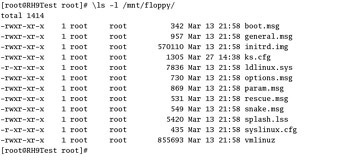Kickstarting from a Floppy
Now that you have a Kickstart file, you should be able to start the Red Hat Linux installation process from the installation boot floppy. Once Red Hat finds and loads your Kickstart file, it may need a driver disk. After it activates needed drivers, Anaconda proceeds to install Red Hat Linux automatically, using the instructions from your Kickstart file. You can then remove the installation and driver disks, and use them to start the process on another computer.
In other words, you can install Red Hat Linux on several computers simultaneously .
Files on a Boot Floppy
Kickstart files are typically small enough to include with the standard Red Hat Linux installation floppy disk. The standard files from the bootdisk.img boot floppy are shown in Figure 5.16. Note that I ve included my ks.cfg file on this floppy.

Figure 5.16: Files on the installation boot floppy
Create a Red Hat Linux installation floppy, using the techniques described in Chapter 03 . Rename any Kickstart file that you ve created as ks.cfg . Copy this file to the installation floppy.
Unfortunately, there isn t enough room to include drivers on the installation boot floppy. If you need additional drivers, you can use the installation boot floppy and the Red Hat Linux installation CD.
| Note | Some companies buy PCs without CD drives to prevent users from loading their own software. |
If your computer does not have a CD drive, you ll need more floppy disks for any drivers that Linux needs to load. As described in Chapter 02 , other floppies can be created from the first Red Hat installation CD, from files in the /images directory. Depending on your configuration, you may need floppies created from one or more of the following: drvnet.img , drvblock.img , and pcmciadd.img .
The Installation Procedure
You re ready with your installation floppies. Insert the Red Hat Linux installation floppy with your Kickstart file into the appropriate drive. If possible, insert the first Red Hat Linux installation CD. Restart your computer, and boot from the installation floppy or the CD. When you see the first installation screen, you ll see the boot prompt, where you can enter the following command:
[F1-Main] [F2-Options] [F3-General] [F4-Kernel] [F5-Rescue] boot: linux ks=floppy
If you ve configured your ks.cfg file properly and booted from the CD, you should be able to remove the floppy and the CD after your computer reads in the startup kernel and appropriate drivers. The installation should proceed automatically.
If you don t boot from a CD, you ll have to insert the appropriate driver floppy disks when prompted. The prompts will be similar to the driver screens shown in Chapter 04 .
Testing Kickstart
Kickstart is useful for installing Red Hat Linux on a group of computers with similar or identical hardware configurations. If you re going to install Kickstart on a large number of computers, it s important to test your installation first.
If you re planning to install Red Hat Linux on a large group of computers, you could stay in the office all night to make sure everything goes right, or you could test your Kickstart installation process on one or two computers. Then you can use Kickstart to install Red Hat Linux on the other computers on your network with additional confidence.
EAN: 2147483647
Pages: 220